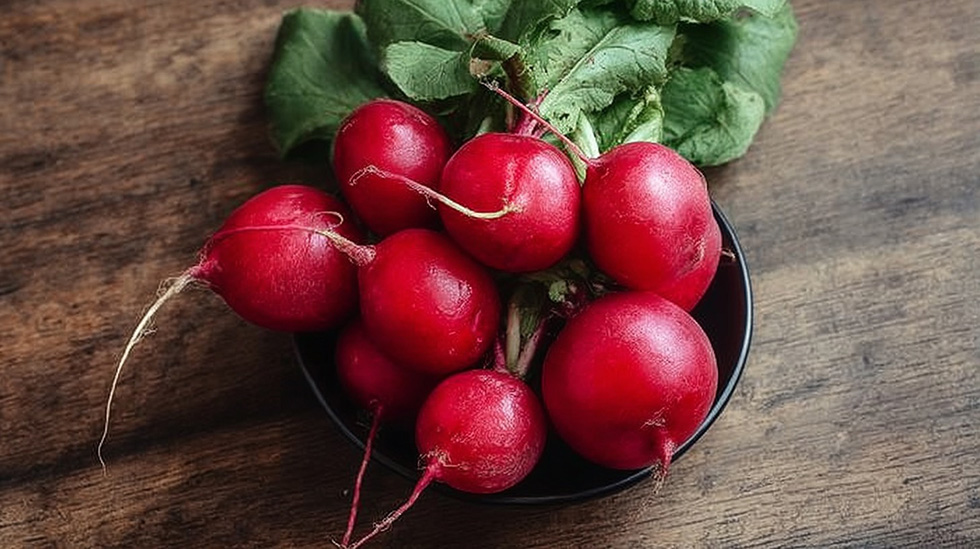Red radishes – the crunchy star of spring
Fresh, tangy, brightly coloured and brightly crunchy – the red radish is not only a faithful companion to the Easter ham, but also a true kitchen superstar! 🌱 This tiny, round vegetable not only adds a lot of flavour, but is also good for your body. Let’s take a look together to see what you need to know about it!

Red radishes are often simply called “radishes”, but they are also known as “radishes of the month” or “spring radishes”. Its Latin name is Raphanus sativus, which means ‘cultivated radish’. 😄 It originates from the Mediterranean and has been eaten for thousands of years – the ancient Egyptians, for example, used to crunch it while building pyramids to give them strength for hard work!
Importance in the kitchen: 3/5
Red radish is not one of the most important vegetables in everyday cooking, but it is a staple in fresh salads, sandwiches and Easter dishes in European – especially Hungarian – cuisine. Simple, quick to use, requiring no cooking, and spectacular, it’s a great way to add a splash of colour and zest to your meals.
Edible parts of the plant
The most commonly eaten part of the red radish is the root – the bright red, rounded part that is eaten raw. It is crunchy and slightly pungent when fresh, but as it ages it loses its crunchiness and becomes slightly spongy.
Few people know, but radish leaves are also edible! It’s also good fresh mixed into salads or wilted and served with pasta, for example. However, it’s important to use only young, whole leaves, as large, old leaves can be too fibrous and bitter. Other parts of the plant, such as the stems or flowers, are not usually used in the kitchen.
Health benefits and nutritional content
Red radish is a real spring immune booster. High in vitamin C, it helps the body’s natural defences and is also a great diuretic. Traditional medicine often recommends it for digestive complaints – it stimulates stomach acid production and helps with bloating.
- Rich in fibre – good for the gut
- Contains calcium, potassium, folic acid
- Low calorie – dieters friend
According to some folk beliefs, radishes “cleanse the blood” – an exaggeration, but one thing is for sure: they help detoxify the body.
Production, season and economic background
The red radish season typically runs from late March to early June – when it is at its juiciest and crispiest. In our country, they are mainly grown outdoors, but there is also greenhouse production, especially in early spring.
The largest producing countries in Europe are the Netherlands, France and Germany. In Hungary, the major radish-growing areas are mainly located between the Danube and the Tisza and in the Transdanubian region.
If you’re looking for really fresh Hungarian produce, look out for labels from April to the end of May – when you’re most likely to find domestic produce. From autumn to early spring, you’re more likely to find imported goods.
How to choose good quality radishes
- Colour: bright red, even surface
- Texture: hard, crunchy – if soft under pressure, it is old
- Leaves: if still on, they should be fresh green – yellowed, wilted leaves are a sign of stale product
Also make sure it’s not cracked or covered in soft spots – these indicate rapid deterioration.
How to store radishes at home?
Fresh radishes don’t like heat – put them in the fridge, preferably in a plastic box or perforated bag. It’s best to cut the leaves off first, as they suck the moisture from the bulb. This will keep them crisp for up to a week. If you’ve bought too many, you can also put the washed, sliced radishes in water in the fridge – they’ll stay fresh for days.
In the kitchens of the world
In Japan, radishes (also in daikon form) are a must with sushi when pickled. In France, it is served with fresh butter and sea salt as a starter. In Mexico, giant radishes are carved into works of art during the “Night of the Radish”! 😍 In the USA, it is often added to salads as a crunchy accompaniment, while in the Arab world it appears in yoghurt sauces as a refreshing element.
Best known recipe: radish salad with sour cream
Ingredients:
- 1 packet red radish
- 2 dl sour cream
- 1 clove garlic (grated)
- 1 pinch of salt
- fresh parsley
Preparation: grate the washed radish, mix with sour cream, salt, garlic and sprinkle with chopped parsley. Serve chilled. Serve it with roasts or fresh bread for a delicious dip! 🥄
Tips for using it in the kitchen
- Adds freshness when diced or grated into salads
- Excellent in sandwiches – heavenly with a little butter and salt
- Use with caution in soups – when cooked, it loses its characteristic spiciness
- Its leaves can also be used as a base for pesto
Spices that go well with it: parsley, chives, black pepper, garlic, lemon juice.
Spices to avoid: strong paprika, cinnamon, nutmeg – they are too strong for this fresh flavour.
Summary
Red radishes are a cheerful, tangy, crunchy vegetable that can not only add a splash of colour to your spring plate, but can also be a guardian of your health. Although not used as a main course every day, it’s a real jolly joker in salads and sandwiches. Freshly crunched, with sour cream or butter – radishes always put a smile on your face! 😊
